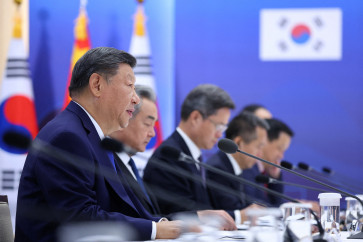Popular Reads
Top Results
Can't find what you're looking for?
View all search resultsPopular Reads
Top Results
Can't find what you're looking for?
View all search resultsFight for gender equality starts at home
A UNESCO report published two years ago argued that gender bias was still present and expanding in textbooks around the world, including in Indonesia.
Change text size
Gift Premium Articles
to Anyone
T
oday is International Women’s Day. Some of us might have celebrated it last Saturday by participating in the Women's March Jakarta 2018. The event reminded us that gender inequality still exists, and that the root of the issue is often ignored.
In 2016, the Culture and Education Ministry received an award from UNESCO for the equality program it implemented as part of its early childhood education (PAUD) policy. However, last year's Human Development Index (HDI) report from the United Nations Development Program (UNDP) declared that Indonesia was still struggling to address its gender gap.
This called to mind my previous studies, including my research on gender representation in education, especially in textbooks and what we can do to educate our children on gender equality.
Before delving further into gender representation in education, imagine for a moment several groups of female and male pupils in an English-language classroom, reading their textbooks and looking at pictures of a woman and a man.
The book has a picture of a woman in her 30s cooking in the kitchen; alongside her is a picture of a man reading a newspaper. Underneath the illustration are questions for the students to answer: “What is Mrs. Brown doing?” and “What is Mr. Brown doing?” You might recall seeing similar pictures and exercises in your textbooks.
Read also: My son learns feminism at school (and at home)
The scene above is an actual illustration in a textbook currently used in the Bandung school where I conducted my research. The content of this textbook is similar to the findings of several research projects outside Asia. The female characters are typically illustrated taking care of children, cooking, doing household chores, and so on.
My study is not the only study that has found gender bias in the English textbooks used in Indonesia. A recent study by Emilia, Moecharam, and Syifa (2017) that looked into two English textbooks from local publishers also found gender stereotypes. The study found that male characters were depicted as "rational", "powerful" and "individual", while female characters were portrayed as "thoughtful", "anxious" and "expressive". Male characters were more often portrayed as active figures or taking part in public activities than female characters.
The results of these two studies seem to echo the findings of the 2016 UNESCO report that argued that gender bias is still present and spreading in textbooks around the world, including in Indonesia.
The effect of this disparity in gender representation is a suggestion that men and boys occupy a more important role in society than women and girls. As a result, the textbooks perpetuate gender inequality and allow it to grow, undermining female students’ dreams, motivations and achievements at school.
Read also: Saraswati Learning Center: A special place for the gifted
However, despite the gender bias depicted in textbooks, we should not overlook our teachers’ capacity to become agents of social change. If teachers are aware of representations of dominance in the material they are expected to teach – such as when using these textbooks as a classroom learning tool – they can become change agents for subverting the representation of gender stereotypes.
Unfortunately, most of the teachers that participated in my study were unaware of their potential in reducing gender inequality. In fact, some of them ignored the stereotypes presented in their textbooks and justified their lack of awareness by stating that their priority was to deliver material on time and helping students pass exams.
There are other reasons for the teachers’ lack of awareness. First, the teachers never received any training or taken a course during their formal education on how to convey a more accurate depiction of men and women, girls and boys, or how to deal with gender stereotypes. Second, during their teaching career, they were never provided with professional development or guidelines on teaching equitable behavior.
However, we can put an end to this obliviousness. One of the ways to do so is by increasing teachers’ awareness of gender biases in textbooks. UNESCO provides a comprehensive and downloadable free guideline on gender equality that teachers and schools can use to identify gender disparity in textbooks, and what they can do to promote gender equality. Teachers who are gender-sensitive can facilitate student discussions on gender stereotypes and neutralize pre-existing gender stereotypes among students as a way to promote equitable behavior.
Another way is to make publishers and authors take proactive measures in removing any gender bias from textbooks before they are printed. The government could also endorse policies that encourage the equal representation of women and men in all kinds of textbooks. For example, textbooks should portray female and male characters in a variety of occupations, appearances and activities in equal amounts.
Even so, we must remember that textbooks and policies are only products. Every student’s first and immediate social interaction takes place at home with their parents. This interaction surely influences how students view gender equality. This brings us to the third and most important means of reducing gender bias in our society: increase parents’ awareness of the gender issue.
Although teachers, textbook publishers and government policies should make active efforts to reduce gender stereotypes, parents’ awareness of the gender issue is critical. Parents play a very significant role in introducing gender equality at home and in being a role model of gender equality for their children. In other words, if parents themselves promote gender stereotypes through simple lessons, like telling their children that pink is for girls and blue is for boys, it reinforces the problem.
Therefore, all in all, the responsibility for eliminating gender inequality is on everyone’s shoulders. We must all start by addressing the issue in our own homes. (dev/kes)
***
Fenty Lidya Siregar is a D3 English teacher at Maranatha Christian University's School of Letters in Bandung. She holds a Doctor of Philosophy in Applied Linguistics from the Victoria University of Wellington, New Zealand. She can be reached at fenty.siregar@outlook.com.
---------------
Interested in writing for thejakartapost.com? We are looking for informative stories and opinion pieces from experts in a variety of fields, and others with appropriate writing skills. All content must be original on any of the following topics: lifestyle ( beauty, fashion, food), entertainment, science & technology, health, parenting, social media, sports. Submit your writing to community@jakpost.com. Click here for more information.











